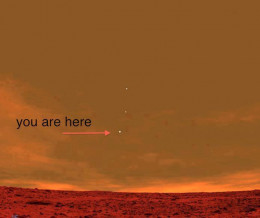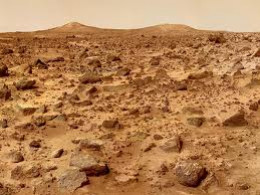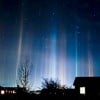Do you notice anything about this photo ?
Do you notice anything about this photo ?
If any of you guys have read or know about the stars of Orions belt, their formation ,alignment, and the surveying and setting out of the pyramids at giza this should spark some questions off for you, especially as this was taken from Mars in 2012 and well basically has anyone got and theory's on this awesome photo ?
Simba
If this picture was taken by the rover on Mars the Orion constellation would look the same as it appear from Earth or from any planet in the solar system. As a matter of fact, all the constellations would appear the same no matter which planet you are on in the solar system because these stars are so far away with respect to the small change in our position in the solar system. In this photo Earth is seen simply lined up with two of the stars in the Orion Belt from this perspective. The sky is not dark enough to see the other stars of the constellation.
Good answer, but would earth be part of the stars formation from Mars on a regular basis? if this happens say every 26,000 years then I'm getting spine chills for sure. I would love to know how often this happens.
Still great answer !!!
SimbaInterestingly, the stars in Orion are so far away that the constellation looks pretty much the same from Alpha Centauri as well. The only difference is the addition of Sirius next to Betelgeuse.
Could you see Sirius with the naked eye then?
Yes - it would be a very bright star from Alpha Centauri.
Most other constellations would look the same as they do from here. However, there would also be an extra star in Cassiopeia - our Sun.
- scottcgruberposted 13 years ago
0
It can't be the Earth lined up with two stars of Orion's belt. Orion is too far below the ecliptic for any of its stars to appear so close to the Earth.
As for what it is, it's difficult to say without knowing when the picture was taken. I tried modeling it in Celestia, and there are no bright stars that appear in the sky near Earth as viewed from Mars right now.
I did find this image while trying to locate the original photo online:
http://astrobob.areavoices.com/files/20 … 24x677.jpg
That looks pretty close to what you posted. I'd say it's Earth and the two moons of Mars captured in the morning twilight. An impressive testament to our technological achievements and a humbling self-portrait at the same time. 
Here's a picture of mars.
Here's an explanation on why the other photo is shopped: http://blogs.discovermagazine.com/badas … s-skyline/Not the answer I was hoping for but defo the best and most plausible, I just can't help being the trusting optimist doh !!!!!
Thanks to all for your answers and great to meet you guys will be checking you out and asking you lots of questions ,Simba
If this is Orion's belt, then Earth is merely temporarily in front of one of the 3 belt stars. Not being able to see other stars, it's hard to confirm that this is Orion's belt.
Such an alignment of Earth would be rare, just like one alignment I saw in Phoenix, Arizona of Venus on the horn of a crescent moon back in 1972. I've never seen one like that since.
Every location in the Solar system, Orion would look exactly the same to the observer. From Alpha Centauri, as my "Stars in the NeighborHood" software shows, Sirius would be right off the shoulder of Orion, near Betelgeuse, and the bow of Orion would be highly distorted with the parallax displacement of Pi-3 Orionis.
Related Discussions
- 14
Do animals know anything about God?
by Mahaveer Sanglikar 11 years ago
Do animals know anything about God?I would like to know that do animals have their own Gods? Or they are unaware abut the existence God?
- 4
Do you know anything about quantum physics?
by Money Fairy 12 years ago
Do you know anything about quantum physics?You had mentioned something about physics in another persons hub. So I thought you may know something about quantum physics. If you do I'd love to ask you some more probing questions:ie: If we are all sub atomic particles why aren't we floating around like...
- 7
Does anybody know ANYTHING about this doll company? It's called Victoria Impex C
by Spirit Of Romance 15 years ago
Does anybody know ANYTHING about this doll company?It's called Victoria Impex Corporation.Does anybody know their website, a site I can buy some from, the rest of the series?~ The Spirit Of Romance.
- 7
If you could change anything about the way you were raised, what would it be?
by Ashantina 14 years ago
If you could change anything about the way you were raised, what would it be?
- 211
Why is Trump not doing anything about the Russians meddling.
by Randy Godwin 7 years ago
With all of Trump's Intel agencies testifying before congress that the Russians meddled in the Presidential election, he has done nothing to prevent this from happening in the future. I cannot imagine any past POTUS ignoring this threat to our country. I realize he doesn't want to bring...
- 27
Anybody know anything about crows?
by pgrundy 16 years ago
Got up this morning to this unbelievable racket that sounded like about 100 crows. It's twelve hours later and they are still at it. As near as I can tell, it isn't 100 after all, it's just a few, and they seem to be stationed in a tree in our yard (right next to the bedroom). I walked under it and...










